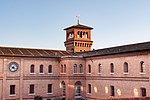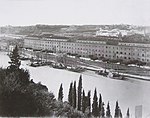Santa Sabina

The Basilica of Saint Sabina (Latin: Basilica Sanctae Sabinae, Italian: Basilica di Santa Sabina all'Aventino) is a historic church on the Aventine Hill in Rome, Italy. It is a titular minor basilica and mother church of the Roman Catholic Order of Preachers, better known as the Dominicans. Santa Sabina is the oldest extant ecclesiastical basilica in Rome that preserves its original colonnaded rectangular plan with apse and architectural style. Its decorations have been restored to their original restrained design. Other basilicas, such as Santa Maria Maggiore, have been ornately decorated in later centuries. Because of its simplicity, the Santa Sabina represents the adaptation of the architecture of the roofed Roman forum or basilica to the basilica churches of Christendom. It is especially famous for its 5th-century carved wood doors, with a cycle of Christian scenes, that is one of the earliest to survive. Santa Sabina is perched high above the Tiber to the north and the Circus Maximus to the east. It is next to the small public park of Giardino degli Aranci ("Garden of Oranges"), which has a scenic terrace overlooking Rome. It is a short distance from the headquarters of the Knights of Malta. Its cardinal priest is Jozef Tomko. It is the stational church for Ash Wednesday.
Excerpt from the Wikipedia article Santa Sabina (License: CC BY-SA 3.0, Authors, Images).Santa Sabina
Piazza Pietro d'Illiria, Rome Municipio Roma I
Geographical coordinates (GPS) Address External links Nearby Places Show on map
Geographical coordinates (GPS)
| Latitude | Longitude |
|---|---|
| N 41.884444444444 ° | E 12.479722222222 ° |
Address
Basilica di Santa Sabina all'Aventino
Piazza Pietro d'Illiria
00153 Rome, Municipio Roma I
Lazio, Italy
Open on Google Maps







